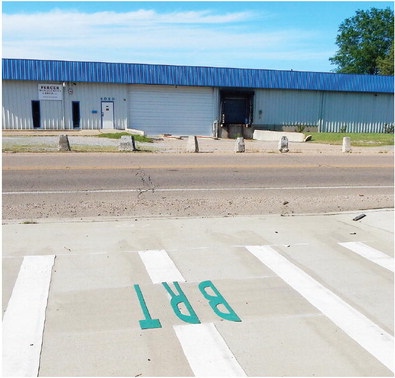Food trucks, new business part of BRX growth plan

Food trucks, new business part of BRX growth plan
Turning tourism into revenue along the Big River Trail
news@theeveningtimes.com
Food trucks are becoming more and more popular, and are being seen as one possible way to grow interest on this side of the river for cycling tourists.
What is the City of West Memphis’ intention on allow for food truck operation? The issue is being bandied about in public forums and private enterprise discussions with increasing frequency now with the spring time traffic rising on the Big River Crossing (BRX). Entrepreneurs want to know what direction the city wants to go for zoning for businesses trying to capture tourism dollars from the cycling tourists.
Traffic counts show 80 percent of the BRX visitors start on the Memphis side.
The inflow presents the question, what are these cycling tourists supposed do after cycling around the new Delta River Regional Park? One West Memphis businessman says he has been turned every which way but loose by city administrators over his ideally located properties for either a food truck or a permanent building between BRX landing the Big River Trailhead (BRT) on East Broadway.
Cham Percer sees cyclists spinning past his Lalman Mobile Home Park everyday but feels handcuffed by zoning and building regulations for his two other parcels that cyclists also ride past. One lot is next to the BRX landing on Dacus Lake Road, a county road long ago named for his family. Percer sees private parking and food concessions as ways of driving tourism visits at the junction of the BRX and the start of the new river park path. The other opportunity is the old Yarnell’s ice cream distribution building on East Broadway.
The West Memphis Advertising and Promotion Commission had two food truck requests to locate outside the civic center under consideration at the April meeting; neither one bore fruit.
“It doesn’t meet zoning,” said Convention and Visitors Bureau Executive Director Jim Jackson.
Councilman James Pulliaum rejected the food trucker requests and defended permanent restaurants collecting the A& P hamburger tax.
“If you got your restaurants here, why would you let food trucks come up here and run around?”
asked Pulliaum.
“It doesn’t set the tone we want,” said Councilwoman Ramona Taylor.
What does the city want to do?
Currently, Broadway from the 1500 block east is zoned C-2 for food trucks, but then only by permit, with property owner permission, and only for ten consecutive days to promote the brick and mortar business, not really enough to establish a “foodie” following at any one spot. Percer has property just north of the BRX landing.
He wants to sell simple hot dog lunches and provide paid parking but BRX construction fenced it off and left no gate access to his gravel road.
“That road has been there since logging days, longer than West Memphis has been a city,” said Percer.
The lot is in unincorporated part of the county but West Memphis paid for part of the construction in the area and holds extra jurisdictional
oversight for planning
and development.
Percer said he had the City Planner Paul Luker and the city engineer along with the construction project manager out to the spot.
“Luker shrugged it off and told me the fence was not done with malicious intent or forethought,” said Percer. “More like no forethought, right now there is no way for me to open it.”
So what does the city want, food truck concessions
or permanent buildings?
During the April meeting the A& P commissioners themselves glanced at a four acre lot for sale north of the Riverside Speedway on Broadway with BRT frontage.
“It has utilities available, it could be used for parking for our bike ride events or even food trucks,” said Jackson. “We could put in lighting, portable toilets and security fencing. The city would have to decide what it wants to do with its food truck policy.”
Though Pulliaum is researching food truck ordinances for local consideration, commissioners didn’t make a peep in response and moved down the agenda.
So what does the city want, public projects or private enterprise, food truck courts or restaurants and retail? A revenue stream is the answer.
“Roof tops,” said Luker in an interview. “The big vision isn’t food trucks. We want to see something more permanent take root there.”
Luker answered questions about East Broadway out from Pancho’s and specifically about the old ice cream works. The whole BRT runs right down the curb on the south side of the main thoroughfare in front of the Yarnell’s.
“I’ve heard there is (Percer) interest,” said Luker. “I think that Yarnell’s building would be a great building for a bike crowd. I could see a coffee bar and couches, like Loflin Yard has taken off in Memphis.”
Percer owns that building too and expressed a similar vision for attracting cycle tourists to the building. But he feels that option is also walled off by city zoning requirements that make it too costly to develop.
“It would need to be rezoned to retail and restaurant,” said Percer. “The minute I do that I’d have to pave parking even though I’m trying to attract bicycle traffic. Gravel was fine for parking when it was ice cream distribution but that would all have to change.”
The March Budget Committee concluded with a discussion over whether planning and zoning requirements actually deterred business development in the city.
“We need to collect stories about this,” said Councilman Tracy Catt who sits on both budget and planning commissions. “If regulations deter development we could take a look it.”
For Percer’s concern, there is a two for one story to start that list. He feels shut out of his own property and discouraged about taking initiative to do business on either end of the BRT.


By John Rech


Share